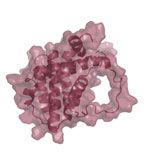Targeting Leukemic Stem Cells in Marrow Could Stave Off TKI Resistance
New research suggests that a novel, investigative drug could help alleviate some of the resistance to tyrosine kinase inhibitor treatment seen in chronic myeloid leukemia (CML). The drug, a pan-BCL2 inhibitor called sabutoclax, could sensitize malignant leukemic stem cells in the bone marrow niche to TKI treatment.
New research suggests that a novel, investigative drug could help alleviate some of the resistance to tyrosine kinase inhibitor (TKI) treatment seen in chronic myeloid leukemia (CML). The drug, a pan-BCL2 inhibitor called sabutoclax, could sensitize malignant leukemic stem cells in the bone marrow niche to TKI treatment.

BCL2 human isoform 2; source: Dan Cojocari, Wikimedia Commons
“Our findings show that pan-BCL2 inhibition will be critical for the eradication of cancer stem cells in CML and that there is an essential link between cancer stem cell dormancy, pro-survival BCL2 isoform expression, and therapeutic resistance,” said senior author Catriona Jamieson, MD, PhD, director of stem cell research at the University of California, San Diego, in a press release. Jamieson and colleagues used whole-transcriptome RNA sequencing and other tools and showed that alternative splicing of genes in the BCL2 family helped turn myeloid progenitor cells into blast crisis leukemic stem cells. Their results were published in the journal Cell Stem Cell in January.
Those blast crisis leukemic stem cells are present in bone marrow, and contribute to the TKI resistance often seen. The researchers wrote that despite survival improvements with newer CML treatments, “no curative pharmacologic therapy for CML exists, partly because the genetic and epigenetic drivers of human BC LSC generation remain to be elucidated.” The “marrow-niche-engrafted” stem cells found in this study expressed isoforms with greater TKI resistance than in other tissue, further explaining why CML can relapse into blast crisis.
The effect of sabutoclax on the leukemic stem cells was notable in particular because the drug reduced cell survival in vitro even at doses that did not harm normal progenitor cells. The authors noted, though, that sabutoclax did not fully eradicate the cells or completely prevent blast crisis leukemic stem cell colony formation, which suggests a need to inhibit multiple proteins in the BCL2 family including MCL1. An experiment in mice also showed that cells treated with sabutoclax then became more sensitive to the TKI dasatinib.
“By using a novel pan-BCL2 inhibitor, we may be able to prevent therapeutic resistance by sensitizing malignant stem cell clones to TKIs,” Jamieson said. The study’s lead author, Daniel J. Goff, also of UCSD, said the drug and concept could work on other cancers as well. These could include prostate, breast, and brain tumors. “With many of these tumor types being shown to harbor cancer stem cells, it raises the question of whether BCL2 family expression as well as isoform-switching may be crucial for the maintenance of cancer stem cells in these diseases as well,” he said in the release. “If so, they may also be candidates for treatment with a BCL2 inhibitor like sabutoclax.”